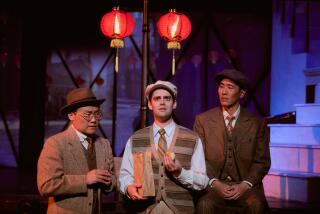FLOWER NET.<i> By Lisa See</i> .<i> HarperCollins: 320 pp., $24</i>
- Share via
The venerable tradition of the Chinese tea serving ceremony might seem at odds with a culture that practices summary executions, but contradictions abound in Lisa See’s novel of political conspiracy and family betrayal. The paradoxical nature of Chinese culture is familiar territory for See, who is also the author of the family chronicle “On Gold Mountain,” in which she weaves anecdote and historic detail to recount the 100-year odyssey of her Chinese American family. In her new novel, “Flower Net,” paradox and contradiction are enmeshed in increasingly ambiguous scenarios that are about as tough to sort out as any 1,000-piece jigsaw puzzle. Following the crisscrossing narrative that moves from China to Los Angeles and back again, the reader quickly begins to feel trapped in a hall of mirrors.
“Flower Net” opens when an elderly Chinese man and his young granddaughter, skating on the iced-over lake in Beijing, discover the frozen body of a young American man, Billy Watson, the son of the American ambassador to China. Heading the case, Inspector Liu Hulan, a smart police officer who “preferred to wear pre-Revolutionary clothes,” must go about the difficult business of informing the victim’s family of their son’s death and pursuing any clues regarding what quickly proves to have been a murder.
Nearly simultaneously, on the other side of the world, Deputy Dist. Atty. David Stark discovers the body of a young Chinese man, his corpse in ghastly condition, floating in the water tank of the freighter China Peony. Eventually the body is identified as that of Kwong Heng-lui, the son of a wealthy and powerful Chinese entrepreneur.
Kwong’s presence on the ship seems shrouded in terror-provoked silence. The China Peony had been floating mysteriously for the last week 200 miles off the California coast without a crew but with about 500 illegal and frightened immigrants on board. The intrigue intensifies when we learn that not only were the two murder victims acquainted but that D.A. Stark and Inspector Hulan had been colleagues and lovers 12 years earlier in Los Angeles.
The graceful rendering of two different and complex cultures, within a highly intricate plot, owes something to the complexity of See’s own background. Daughter of a Chinese American father and white mother, Richard See and Carolyn See (a Los Angeles-based novelist), See spent a good part of her childhood in Los Angeles’ Chinatown and later traveled extensively in China, where she researched her ancestry. Her access to both cultures has given her an unusual ability to communicate nuance and subtlety from a Chinese and an American perspective.
Through her heroine, Hulan, we learn about the ease with which double meanings can be expressed in Chinese, a capacity that See deftly employs to heighten the intrigue during some of the novel’s most dramatic moments. The starkly beautiful landscapes of Beijing and its surrounding countryside are depicted with a lyrical precision that would seem to come from a deeply abiding connection to the land and its peoples. Also vivid, exact and without any cloying traces of exoticism are See’s descriptions of the strangely neon but distinctly Asian decor of the shops and streets of L.A.’s Chinatown.
And it is to Chinatown that Stark and Hulan turn, searching for links between the two murders and the Rising Phoenix, a Chinese triad involved in an assortment of organized crime, from trafficking narcotics and smuggling Chinese medicines made from endangered wildlife to conducting other far more subversive activities. When the investigation stalls, Stark, feeling baffled and disoriented, turns to Hulan for direction. She tells him that in China she would cast a “flower net,” a term derived from an ancient method of fishing, whereby a “round, hand-woven net with weights on the edges” is cast into the water where it “opens like a flower, sinks into the dark depths, and traps everything within its circumference.” Merging wide open assertiveness with a more discreet probe, Stark and Hulan intensify their investigation but are hardly prepared for the disturbing connections they bring to surface.
See captures China after the Cultural Revolution in all its harshness, giving insight into the devastating effects of government oppression on its people, particularly on their family relationships. Demanding that its citizens hold family loyalty second to strict adherence to government policy, China’s authorities are shown to foster an atmosphere in which a child might easily betray a parent or a husband his wife. Far from one-sided, however, the novel portrays family betrayal and government corruption in America, suggesting that although their sources may be differently motivated, the results can turn out to be disturbingly symmetrical.
More to Read
Sign up for our Book Club newsletter
Get the latest news, events and more from the Los Angeles Times Book Club, and help us get L.A. reading and talking.
You may occasionally receive promotional content from the Los Angeles Times.







